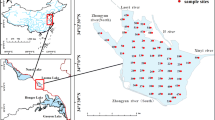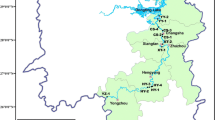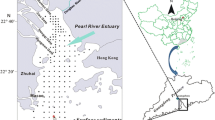Abstract
Management of sediments in polluted rivers requires an inventory of sediment quantities as well as their nutrient and metal contents and the chemical forms of pollutants. We investigated the influence of three major land uses (i.e., orange plantation—OP, OP + residential + industrial—OPRI, and residential + industrial—RI) on the quality of surface sediments (0–20 cm below water/sediment interface) at the Sanyang Wetland (China). The total contents of metals (As, Cd, Cr, Cu, Ni, Pb, and Zn) and nutrients (C, N, and P) as well as metal speciation in sediments were examined. GIS technology was used to estimate the volume of sediments needed to calculate the amounts of stored nutrients and metals in sediments. The surface sediments in the 3.2-km2 study area contain more than 2800 Mg C, 200 Mg N, and 100 Mg P. OPRI and RI land uses contribute more total C, N, P, Zn, and Cd to sediments than OP land use. High contents of C, N, and P may provide options to recycle the sediments as fertilizer but must be used with caution due to high levels of metals. Total Cd in sediments is at an order of magnitude (up to 59 mg kg−1) higher than the Level III criterion in the Chinese Environmental Quality Standards for Soil. Sediments in all land uses have very high risks due to >50% exchangeable + carbonate-bound Zn, Ni, and Cd. It is suggested that toxicity tests be conducted to better assess the environmental risks associated with any potential use of sediments.



Similar content being viewed by others
References
Agrawal A, Kumar V, Pandey BD (2006) Remediation options for the treatment of electroplating and leather tanning effluent containing chromium—a review. Min Proc Ext Met Rev 27:99–130
Burt R (2004) Soil survey laboratory methods manual. Soil survey investigation report no. 42, version 4.0, Nov 2004, USDA-NRCS Lincoln, Nebraska
Chen Z (2008) Quantitative studies using scenario planning method for landscape planning: a case study of Sanyang Wetland park of Wenzhou, China. MSc thesis (in Chinese), Tongji University, Shanghai, China
Chen H, Arocena JM, Li J, Thring RW, Zhou J (2012) Mobility and storage sinks for chromium and other metals in soils impacted by leather tannery wastes. J Environ Monit 14:3240–3248
Csicsovszki G, Kékesi T, Török TI (2005) Selective recovery of Zn and Fe from spent pickling solutions by the combination of anion exchange and membrane electrowinning techniques. Hydrometallurgy 77:19–28
Curry N, Pillay P (2012) Biogas prediction and design of a food waste to energy system for the urban environment. Renew Energy 41:200–209
ESRI Inc. (2014) About 3D surfaces. http://www.esri.com/. Date Accessed: 9 May 2014
Gao X, Chen A (2012) Heavy metal pollution status in surface sediments of the coastal Bohai Bay. Water Res 46:1901–1911
Haroun M, Idris A, Syed Omar SR (2007) A study of heavy metals and their fate in the composting of tannery sludge. Waste Manag 27:1541–1550
Hass A, Fine P (2010) Sequential selective extraction procedures for the study of heavy metals in soils, sediments, and waste materials—a critical review. Crit Rev Env Sci Tec 40:365–399
HKEB (Hong Kong Environment Bureau) (2013) Hong Kong blue print for sustainable use of resources 2013–2022. Hong Kong
Idris A, Inanc B, Hassan MN (2004) Overview of waste disposal and landfills/dumps in Asian countries. J Mater Cycles Waste Manage 6:104–110
IGGE (Institute of Geophysical and Geochemical Exploration) (2012) Level 1 standard materials for geochemical analyses (1982–2012). Institute of Geophysical and Geochemical Exploration, Langfang
Jain CK, Rao VG, Prakash BA, Kumar KM, Yoshida M (2010) Metal fractionation study on bed sediments of Hussainsagar Lake, Hyderabad, India. Environ Monit Assess 166:57–67
Jönsson H, Stintzing AR, Vinnerås B, Salomon E (2004) Guidelines on the use of urine and faeces in crop production. EcoSanRes Programme. www.ecosanres.org, Date Accessed: 9 May 2014
Kabas S, Faz A, Acosta JA, Arocena JM, Zornoza R, Martínez-Martínez S, Carmona DM (2014) Marble wastes and pig slurry improve the environmental and plant-relevant properties of mine tailings. Environ Geochem Health 36:41–54
Kamjunke N, Büttner O, Jäger CG, Marcus H, von Tümpling W, Halbedel S, Weitere M (2013) Biogeochemical patterns in a river network along a land use gradient. Environ Monit Assess 185:9221–9236
Kumar A, Kumar R, Sudarsan JS (2010) Biogas manure (BGM) from mixed kitchen waste: a trial study. J Environ Res Develop 5:164–171
Kuusisto-Hjort P, Hjort J (2013) Land use impacts on trace metal concentrations of suburban stream sediments in the Helsinki region, Finland. Sci Total Environ 456–457:222–230
Li Y, Jin M, Wang Y (2010) Underwater digital elevation model validation and accuracy assessment. In Geoscience and Remote Sensing (IITA-GRS), 2010 Second IITA International Conference on Geoscience and Remote Sensing 2: 302–305
Liu H, Li L, Yin C, Shan B (2008) Fraction distribution and risk assessment of heavy metals in sediments of Moshui Lake. J Environ Sci 20:390–397
MAPRC (Ministry of Agriculture of the People’s Republic of China) (1988) China national standard (method for determination of soil total phosphorus, GB8937–88). http://kjs.mep.gov.cn/hjbhbz/bzwb/, Date Accessed: 9 May 2014
MEPPRC (Ministry of Environmental Protection of the People’s Republic of China) (2009) Environmental Protection Standards in China (determination of ammonia nitrogen—Nessler’s reagent spectrophotometry, HJ 535–2009). http://kjs.mep.gov.cn/hjbhbz/bzwb/, Date Accessed: 9 May 2014
MEPPRC (Ministry of Environmental Protection of the People’s Republic of China) (2011) Environmental Protection Standards in China (determination of soil organic carbon—potassium dichromate oxidation spectrophotometric method, HJ 615–2011). http://kjs.mep.gov.cn/hjbhbz/bzwb/, Date Accessed: 9 May 2014
MEPPRC (Ministry of Environmental Protection of the People’s Republic of China) (1995) Environmental Protection Standards in China (environmental quality standard for soils, GB 15618–1995). http://kjs.mep.gov.cn/hjbhbz/bzwb/, Date Accessed: 9 May 2014
Nemati K, Bakar NKA, Abas MR, Sobhanzadeh E (2011) Speciation of heavy metals by modified BCR sequential extraction procedure in different depths of sediments from Sungai Buloh, Selangor, Malaysia. J Hazard Mater 192:402–410
Niemitz J, Haynes C, Lasher G (2013) Legacy sediments and historic land use: Chemostratigraphic evidence for excess nutrient and heavy metal sources and remobilization. Geology 41:47–50
Qiao W, Yan X, Ye J, Sun Y, Wang W, Zhang Z (2011) Evaluation of biogas production from different biomass wastes with/without hydrothermal pretreatment. Renew Energy 36:3313–3318
Quevauviller P, Rauret G, López-Sánchez JF, Rubio R, Ure A, Muntau H (1997) Certification of trace metal extractable contents in a sediment reference material (CRM 601) following a three-step sequential extraction procedure. Sci Total Environ 205:223–234
Samaniego H, San Román MF, Ortiz I (2007) Kinetics of zinc recovery from spent pickling effluents. Ind Eng Chem Res 46:907–912
Shomar B (2009) Sources and build up of Zn, Cd, Cr and Pb in the sludge of Gaza. Environ Monit Assess 155:51–62
Singh A, Kuila A, Adak S, Bishai M, Banerjee R (2012) Utilization of vegetable wastes for bioenergy generation. Agri Res 1:213–222
Singh KP, Mohan D, Singh VK, Malik A (2005) Studies on distribution and fractionation of heavy metals in Gomti river sediments—a tributary of the Ganges, India. J Hydrology 312:14–27
Sparks DL (2003) Environmental soil chemistry, Second edn. Academic Press, New York ISBN 10:0126564469
StatSoft, Inc. (2013). STATISTICA (data analysis software system), version 12. www.statsoft.com, Date Accessed: 9 May 2014
Sundaray SK, Nayak BB, LinS BD (2011) Geochemical speciation and risk assessment of heavy metals in the river estuarine sediments—a case study: Mahanadi basin, India. J Hazard Mater 186:1837–1846
Tessier A, Campbell PGC, Bisson M (1979) Sequential extraction procedure for the speciation of particulate trace metals. Anal Chem 51:844–851
Tong C, Feagin RA, Lu J, Zhang X, Zhu X, Wang W, He W (2007) Ecosystem service values and restoration in the urban Sanyang wetland of Wenzhou, China. Ecol Eng 29:249–258
WEPB (Wenzhou Environmental Protection Bureau) (2014) Wenzhou Environment Quality Report for 2013 (In Chinese). Wenzhou, China
Xu G, Liu J, Pei S, Gao M, Hu G, Kong X (2015) Sediment properties and trace metal pollution assessment in surface sediments of the Laizhou Bay, China. Environ Sci Pollut Res 22:11634–11647
Yue H, Song T, Chen Y, Wang J (2005) Wenzhou Sanyang wetland water pollution causes and treatment strategies (in Chinese). Environmental Design Research Institute, Wenzhou, Zhejiang
Zhao L, Mi D, Chen Y, Wang L, Sun Y (2015) Ecological risk assessment and sources of heavy metals in sediment from Daling River basin. Environ Sci Pollut Res 22:5975–5984
Acknowledgements
We wish to thank the support from the Zhejiang Provincial and Wenzhou Municipal governments through the Foreign Experts program to undertake this study. Drs. JM Arocena, RW Thring, and JB Li acknowledge the Discovery Grant program of the Natural Sciences and Engineering Research Council of Canada that enabled them to participate in this research collaboration. This study was funded by the Department of Science and Technology of Zhejiang Province (Project No. 2012C23023), Zhejiang Environmental Protection Bureau (Project No. 2011B26), and Wenzhou Science and Technology Bureau (Project No. S20150022). The authors dedicate this paper to the memory of co-author Dr. Joselito Arocena, a respected researcher in the field of soil science, and a friend, who sadly passed away on December 20, 2015.
Author information
Authors and Affiliations
Corresponding author
Additional information
Responsible editor: Hailong Wang
Rights and permissions
About this article
Cite this article
Li, Y., Arocena, J.M., Zhang, Q. et al. Heavy metals and nutrients (carbon, nitrogen, and phosphorus) in sediments: relationships to land uses, environmental risks, and management. Environ Sci Pollut Res 24, 7403–7412 (2017). https://doi.org/10.1007/s11356-017-8385-y
Received:
Accepted:
Published:
Issue Date:
DOI: https://doi.org/10.1007/s11356-017-8385-y




